
The Lisbon waterfront in 2003: a catamaran and Barreiro ferry at the Cais da Alfândega (2003).
Part Two of this Page covers the now merged Transtejo and SOFLUSA ferry services, as well as the history of Trans-Tagus ferries.
Lisbon lies on the River Tagus (Rio Tejo), about 10km from its mouth at the Atlantic Ocean. The river is about 2km wide opposite the city centre and its depth reaches a maximum of 41 metres, about two-thirds of the way across from Lisbon to Cacilhas. For many years there was a very intensive service of conventional ferry boats to half a dozen destinations on the southern bank. However, with the opening of the Fertagus railway line and the new Vasco da Gama road bridge, services have been reduced but nevertheless remain frequent to Cacilhas and Barreiro and less frequent to Seixal, Montijo, Porto Brandao and Trafaria. Catamarans are now exclusively used to the more distant destinations on the 'Outra Banda', the southern side of the river. Until the new millenium, there were five ferry terminals (estações fluviais) on the Lisbon side of the Tagus, though the first two mentioned below, the Estação do Sul e Sueste and the Cais da Alfândega were adjacent and effectively one site.
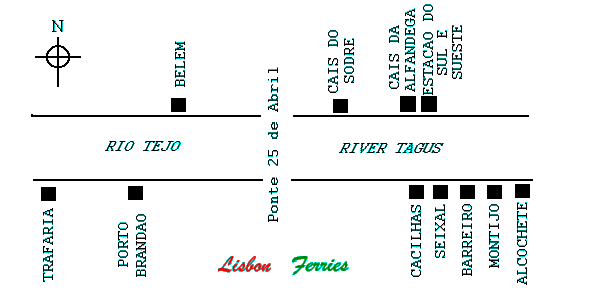
Estação do Sul e Sueste/ Terreiro do Paço
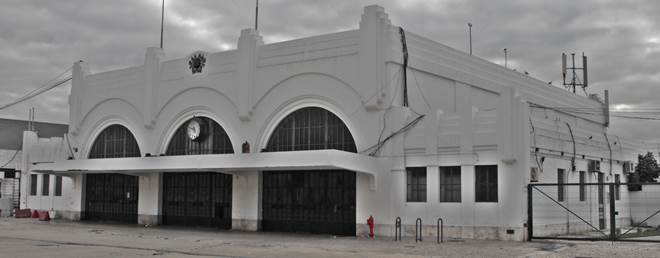 The South and South East Station (Estação do Sul e Sueste) was an iconic ferry terminal - seen right - which lies just off the waterfront Praça do Comércio, to the east. It was actually a railway facility as well as a ferry terminal, for until late 1999 all CP railway services south of Lisbon had to be reached by taking the ferry from here to Barreiro.
The South and South East Station (Estação do Sul e Sueste) was an iconic ferry terminal - seen right - which lies just off the waterfront Praça do Comércio, to the east. It was actually a railway facility as well as a ferry terminal, for until late 1999 all CP railway services south of Lisbon had to be reached by taking the ferry from here to Barreiro.
However, it was closed in 2011, and the building fell into an increasingly shabby state. However, it was repainted c.2015 though it remains out of use. Inside were some interesting tile works representing various parts of Portugal but these appeared to be being removed in 2010.
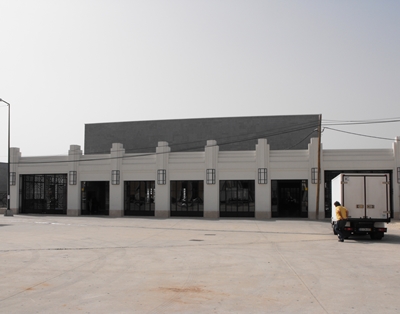 In 2011 an adjacent, brand-new terminal replaced it, next door, to the east (pictured left). This provides a direct link to the adjacent Terreiro do Paco metro station.
In 2011 an adjacent, brand-new terminal replaced it, next door, to the east (pictured left). This provides a direct link to the adjacent Terreiro do Paco metro station.
Historically, to travel south of Lisbon by train required a ferry trip to Barreiro where trains started out for the south of Portugal. Ferry services to Barreiro were operated by the Sociedade Fluvial de Transportes S.A. - SOFLUSA, which is now part of the Transtejo ferry operation. Since the new Tagus Bridge railway line was linked to the CP mainline on the south bank of the Tagus, through-trains have been able to run from Lisbon to the southern bank and beyond, thus threatening the future of the Barreiro ferry services.
The Estação do Sul e Sueste was also locally known as the Terreiro do Paço terminal (or "Palace Grounds", a reference to the royal palace which stood near here until it was destroyed by the 1755 earthquake). Services to Barreiro on conventional ferries took 30 minutes and operated more than sixty times a day in each direction in 2003 but they have now been replaced by faster services by catamaran. Services at Barreiro terminate at a modern terminal which provides a covered walkway to Barreiro railway station (opened 1884) from whence irregular trains leave for Setúbal, Évora and the south of Portugal.
Barreiro became a city in 1984 and was an important ship-repair centre. The terminal in Lisbon at Sul e Sueste was blighted for almost a decade by the interminable works to extend the Metro to Santa Apolónia, work which was completed in December 2007. However, the waterfront around the terminal remained a construction site until 2009 as sewer works took place. By 2016 the works had gone but the space remains somewhat lacking in any purpose. Access to the Barreiro ferry is much improved now by the opening of the Terreiro do Paço metro station adjacent to the ferry terminal and the re-opening of access to the waterfront at the Cais das Colunas where, historically many famous dignitaries landed in Lisbon.
Between the Cais das Colunas and the ferry station is the starting point for the ferry cruise service, branded as "Yellow Boat" and operated by the ferryboat S. Paulus. Adjacent is the poster describing the service in 2016. Cruises normally go as far as Belém (downriver) and the Parque das Nações (upriver).
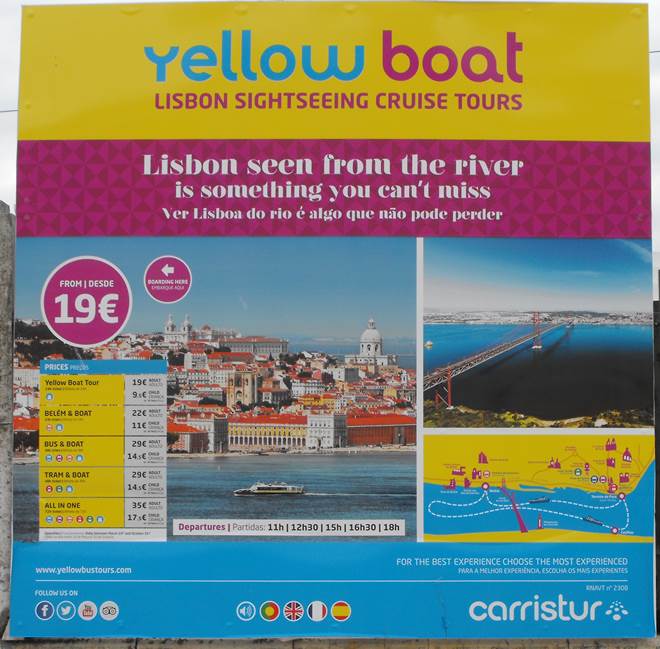
Cais da Alfândega/ Customs' Quay
 The presence of the Ponte 25 de Abril over the last five decades and the more recent opening of the rail section of that bridge have not, however, led to the complete demise of the short-distance cross-Tagus ferries. There remains an intensive passenger ferry service operated by Transtejo, a company formed from the merger of two longstanding separate companies, Transtejo and SOFLUSA. Transtejo's main operational base until a few years ago was the Cais da Alfândega (Customs' Quay), immediately adjacent to the Sul e Sueste ferry station building proper. However, the protracted problems in building a Metro tunnel under the waterside site meant that most of these services were transferred about half a mile further west, to Cais do Sodré, several years ago. A large new terminal was opened at Cais do Sodré (c.2004) underlining the permanency of this relocation.
The presence of the Ponte 25 de Abril over the last five decades and the more recent opening of the rail section of that bridge have not, however, led to the complete demise of the short-distance cross-Tagus ferries. There remains an intensive passenger ferry service operated by Transtejo, a company formed from the merger of two longstanding separate companies, Transtejo and SOFLUSA. Transtejo's main operational base until a few years ago was the Cais da Alfândega (Customs' Quay), immediately adjacent to the Sul e Sueste ferry station building proper. However, the protracted problems in building a Metro tunnel under the waterside site meant that most of these services were transferred about half a mile further west, to Cais do Sodré, several years ago. A large new terminal was opened at Cais do Sodré (c.2004) underlining the permanency of this relocation.
For some time the services which remained at Terreiro do Paço included the following but these have now moved to the new ferry terminal at Cais do Sodré.
Seixal, 10km across the river and takes about half an hour to reach by ferry-boat but less by catamaran. Seixal has an attractive waterfront despite the presence of much heavy industry. At the mouth of the Rio Judeu are a number of small boatyards. The Ecomuseum, opened in 1982, in the Praceta Adolfo Coelho is worth a visit.
Montijo (Seixalinho) is about 15km away. The town was known to generations of early British travellers by its former name of Aldeia Galega. It formally became Montijo in 1930. Service frequency is variable and the trip formerly took about 55 minutes by ferryboat but now takes about 30 minutes by catamaran. The town is a centre for cork production and of meat processing plants. Montijo has a municipal museum in the Casa Mora in the Avenida dos Pescadores. It can also be reached by bus, from Oriente, across the new Ponte Vasco da Gama.
Alcochete is also about 15km away. This long-established ferry service was suspended in 1996 but resumed c.2004 only to be suspended once more by 2006 and has now ceased for good. The Alcochete area can also now be reached via the Vasco da Gama bridge. The town was the birthplace of King Manuel I, in whose reign (1495-1521) many of Portugal's greatest maritime exploits occurred. Worth a visit is the Museu Municipal (Municipal Museum) in the Rua Dr Ciprião de Figueiredo.
Cais do Sodré Terminal
The strangely anonymous modern terminal at Cais do Sodré has an inter-connecting walkway from the platforms of Cais do Sodré railway station, the terminus of the Cascais line. But like Lisbon's new railway stations (Oriente, Entrecampos, Sete Rios and Roma/Areeiro), the building is dull in appearance and has little on its outside (nothing at all on the riverfront side) to signify what it is.
Viva Viagem tickets can be bought from machines or from a staffed ticket office. These give access via a turnstile to a waiting area. An automated gate is opened when the ferry is ready to be boarded. By summer 2008 an extension was already being built to the west end of the premises.
Note that, although the ferries use the Viva Viagem ticketing system, tickets are NOT interchangeable with those issued for the Metro, trams or buses of Lisbon. Those issued by the Metro bear numbers preixed "ML" (Metro de Lisboa); those issued by the ferries are prefixed "TT" (TransTejo). In other words, if you have an "ML" ticket (which looks otherwise identical to an "TT" ticket), with value on it, this cannot be used for a ferry ride and vice versa! However, an "ML" ticket can be used on Carris buses and trams as well as on the Metro. Strangely, "ML" Viva Viagem tickets are also issued on the Setúbal to Tróia ferries, some forty miles away from Lisbon!
The locations served by the Transtejo e SOFLUSA ferries from Cais do Sodré are as follows:
Cacilhas, which lies some 2km away from Lisbon. The ferry service, still operated by ships rather than catamarans, has a journey time is about ten minutes. If you want see Belém and the Ponte 25 de Abril, sit on the starboard side of the vessel on the outward journey. Immediately outside the Cacilhas ferry terminal, as well as the terminal station (2008) of the MST tram service which includes Almada, Pragal and Corroios as its destinations, a large bus station is to be found, which provides extensive services across the southern side of the Tagus, to such places as Sesimbra (beaches) and Almada (including service 101, which will take you to the Cristo Rei statue which overlooks the Tagus). For further details, see the Lisbon Suburban Buses page.
You can also reach the Boca do Vento elevator by walking along the quayside for about 15 minutes, (turn right on disembarking from the ferry). This lift takes you up to Almada from where it is a moderate walk to the Cristo rei monument.
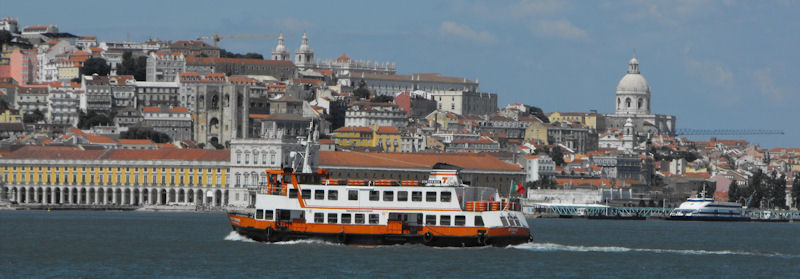
Above: The Cacilhas crossing affords an excellent view of the Lisbon skyline. Here "Sintrense" heads for Cais do Sodré.
Weekday ferry service frequency to Cacilhas is very frequent until the evening but services do continue till late into the night. Sometimes a number of ferries are tied up to the west of the terminal at Cacilhas, though their number is much smaller now that catamarans are so prevalent on other cross-Tagus routes. On the Lisbon side of the river the boats are less visible behind the terminal but can be captured on cameras as they arrive by standing on the quay to the east of the ferry station at Cais do Sodré.
A row of restaurants, specialising in fish dishes, lines the Cacilhas waterfront adjacent to the ferry terminal. In the past, to the left of the exit from the ferry terminal one could invariably see large merchant ships in Lisnave's Margueira ship-repair docks. Beyond the former Lisnave ship-repair docks lies a Portuguese navy harbour (Alfeite). A kilometre or two along the coast towards the bridge lies the Museu Naval (Naval Museum) at Almada.
Car ferries are also still operated regularly from Cais do Sodré to Cacilhas. These survive, not least, because the ferry is much more accessible from central Lisbon than it is by taking the long approach road through western Lisbon to the often congested 25 de Abril toll bridge or by driving out to the Vasco da Gama bridge to the north of the capital. The car ferries have now largely been withdrawn though two car ferries remain in the Transtejo fleet, operating from Cais do Sodré.
Belém
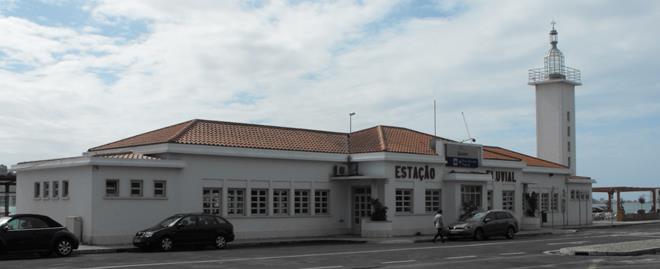
Above: Belem's ferry station, 2016.
Passenger ferries run from this terminal (above), about 5km from the city centre to the west, to Porto Brandão (3km) and from there, on to Trafaria (5km). Each service runs about every 30 minutes. From Trafaria, the extensive beaches of the Costa de Caparica may be reached. The Belém to Trafaria service was reported in January 2012 to cost 3.2 milion Euros per annum to operate and it produced only 0.4 Euros of annual income but, so far, opposition to its closure has succesfully staved off its demise. Car ferries operate on this service.
Parque das Nações
This is the former site of Expo 98, adjacent to Oriente station. Until at least 2005, a weekend ferry service linked it to Cacilhas, Barreiro and Seixal but this has since been withdrawn.
The Ferry Boat Service and Fleet
In 1975, after the Portuguese Revolution, the ferry service was nationalised and the operator was re-named Transtejo. Two years later five ex-Hamburg ferries were acquired and further acquisitions were made between 1981 and 1984, and in the 1990s. The most striking change was the acquisition of British-built catamarans which started on the service to Montijo in 1995. Later catamarans have been built in Australia or Singapore. Transtejo celebrated its 25th anniversary on 21 July, 2000 by holding a "festa" for all of its employees at the Seixal terminal.

Ferries remain very cheap and frequent and afford great views of Lisbon from the river. Despite the advent of the two fixed-river crossings, the expansion of population on the south bank of the estuary has helped to keep the ferry routes well used, if less so than in the past. The 2008 completion of the MTS metro link to Cacilhas arguably boosts traffic, as the metro terminal is just across the road from the ferry terminal.
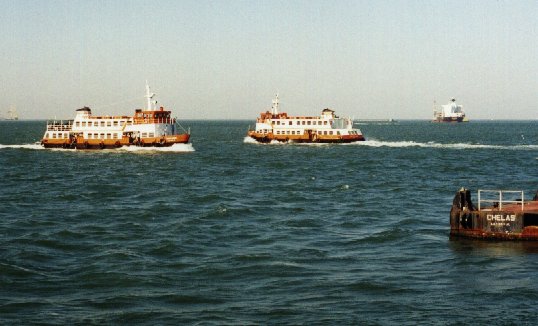
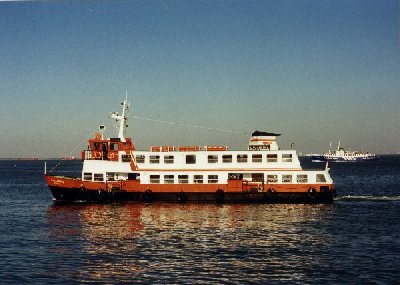
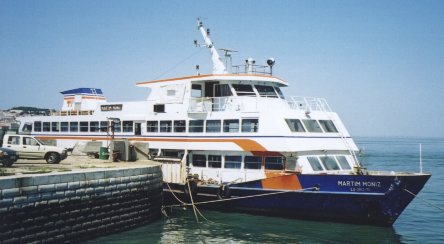
A busy scene at the Cacilhas landing stage, July, 2000; Martim Moniz at Cacilhas, June 2002.
Ferry Passenger Statistics
Passengers carried in 2013 (latest available in 2016 on TT website) were as follows:
- Belém to Trafaria/Porto Brandão 538,863 (-9% compared with 2012)
- Cais do Sodré to Cacilhas 9,713,192 (-8.3%)
- T. do Paço to Barreiro 9,756,503 (+0.3%)
- T. do Paço to Montijo 1,460,762 (-4.1%)
- Cais do Sodré to Seixal 1,654,345 (-6.4%)
- Total..........................23,033,165 (-4.4%)
According to the official Anuário Estatístico de Portugal, 1997 published in late 1998, the following numbers of passengers were carried on the routes indicated during 1996:
- Belém to Trafaria 1,352,000
- Belém to Porto Brandão 355,000
- Cais da Alfândega to Cacilhas 19,968,000
- Cais do Sodré to Cacilhas 9,758,000
- T. do Paço to Barreiro 12,736,000
- T. do Paço to Montijo 1,728,000
- T. do Paço to Seixal 1,481,000
- Total..........................47,378,000
By way of comparison, the fixed link, Ponte 25 de Abril carried 50,134,000 passengers in 1996.
Transtejo e SOFLUSA Ferry Boat Fleet
As of 2016 the Transtejo e SOFLUSA fleet comprised 30 vessels which included 21 catamarans and just six of the traditional cacilheiro ferryboats.
The catamarans were named Damião de Goes, Miguel Torga, Fernando Namora, Gil Vicente, Jorge de Sena, Almeida Garrett, Fernando Pessoa, Antero de Quental, Cesário Verde, Pedro Nunes, Fantasia, Aroeira, Carnide, Sé, São Julião, Algés, Castelo, Chiado, São Jorge and Lisbonense e Almadense.
The surviving cacilheiros were named Campolide, Dafundo, Palmelense, Seixalense, Sintrense, São Paulus and the car-ferry Eborense
By comparison, the total combined fleet in 2007 was 38 vessels of which 22 were catamarans, 2 were car ferries and 14 were passenger ships. The surviving ships were: Campolide, Dafundo, Palmelense, Seixalense, Sintrense, Madragoa, Montes Claros e Moscavide which belong to the "Classe Cacilhense" which entered service between 1980 and 1982. They were built by FOZNAVE, at Figueira da Foz, Argibay at Alverca and the Estaleiro Naval de São Jacinto. Their capacity is c.480.
Also still in service at that time were Marvila, Mouraria, São Paulus e Trafaria Praia, the larger Martim Moniz and S. Jorge plus two car ferries, Eborense and Alentejense.
Details of these and other recently operated ferries are below:
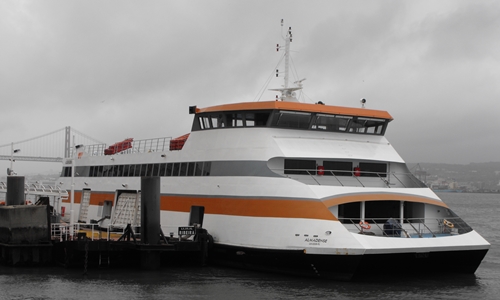
Almadense and Lisbonense These are vehicle-carrying catamarans delivered in early 2011 and serving the Cacilhas - Cais do Sodré route.
Length: 47.50m, 1479 metric tons gross. Operating speed is 11 knots and the vessels are powered by two 850hp diesel engines. They were built by Estaleiros Navalria, Grupo Martifer at Aveiro, Portugal.
Pictured right on a gloomy October day in 2013 is Almadense, tied up at Cacilhas.
Alentejanense Reg. No: L-2822-TL. Built 1957. 355 tons gross. 38.54m x 8.15m
x 2.56m. 681 passengers and 4 crew, or 462 if used as a car ferry. Built by Estaleiros Navais de
Viana do Castelo. The original Sulzer 650hp engine was replaced in 1991
by a 495hp MTU engine giving an operating speed of 10km/hr. Until 1983 used
on the route to Montijo but since then on the Cais do Sodré to
Cacilhas service.
Eborense Reg. No: L-2794-TL. Built 1954. 393 tons gross. 47.04m x 11.22m x 2.3m. 346 passengers and 5 crew. Built by Estaleiros Navais de
Viana do Castelo. The original 2 x Sulzer 600hp engines were replaced in 1991 by 2 x 495hp MTU engines giving an operating speed of 11km/hr.
Monte Pragal Reg. No: L-2874-TL. Built 1946. 361 tons gross. 41.64m x 11.02m x 2.68m. Car ferry + 94 passengers, or 1004 passengers only, plus 5 crew. Built by Cokerill at Hoboken, Belgium. Sold to Lisbon in 1959. The original 2 x Sulzer 400hp engines were replaced in 1991 by 2 x 425hp Cummins engines in 1989, when it underwent a
major refit after being out of use since 1983. It operated the Belém-Porto Brandão car-ferry service. This vessel has had a number of accidents: on 15 May 1979 it collided with a German vessel, the Schwaneck in fog, and on 22 October 1980 it hit the wreck of the MV Tollan which had sunk some time earlier off Cais do Sodré.
In 1990 the vessel suffered fire damage whilst being refitted. From 1990 it ran on the Cacilhas service from Cais do Sodré. In 1992 the
accommodation was upgraded.
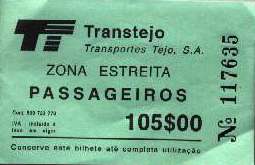
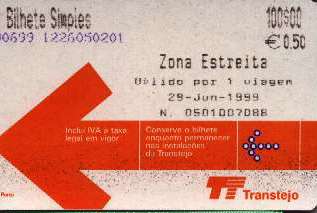
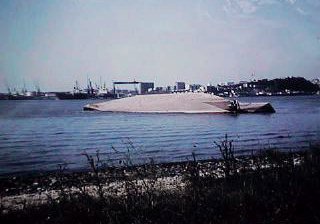
Left to right: a Transtejo ferry ticket as bought from a kiosk; a Transtejo ticket from a vending machine (1999); the wreck of the M.V. Tollan
near the Cais da Alfândega
Nacional Reg. No: L-3105-TL. Built 1936. 164 tons gross. 29.3m x 8.02m
x 3m. 625 passengers and 4 crew. Built by H.C. Stulcken as Cuxhaven.
Brought to Portugal in 1967 to operate on the Cacilhas services. It has a 550hp Deutz diesel
engine giving a speed of 11km/hr. Since 1989, after an overhaul,
the vessel has been used for Tagus cruises.
Sesimbrense Reg. No: L-2830-TL.
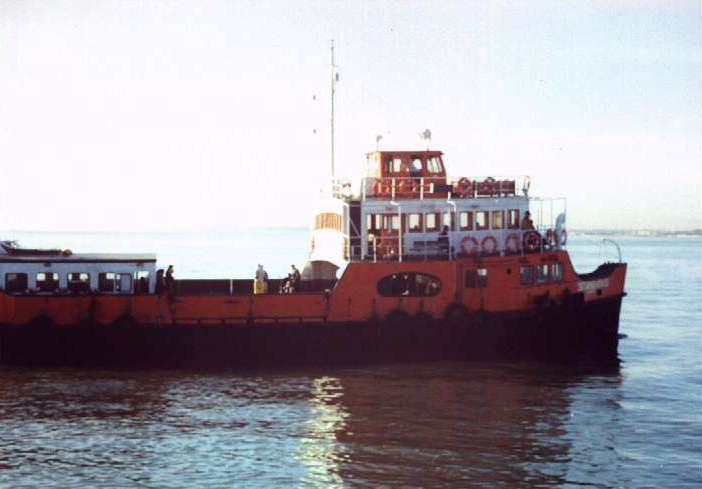 Pictured left at Cais do Sodré in April 1999, Sesimbrense was built in 1958. 357 tons gross. 38.54m x 8.15m x 2.56m. 709 passengers and 5 crew. Built by Estaleiros Navais de
Viana do Castelo. A sister-ship to Alentejense, the original
Sulzer 650hp engine was replaced in 1991 by a 495hp MTU engine giving an operating speed of 10km/hr. Until 1983 used
on the route to Montijo but since then on the Cais do Sodré to
Cacilhas service. The vessel had a full refit in 1990 and a new 425hp Cummins
engine was installed, giving a service speed of 10kt/hr. She
returned to service in 1993.
SetubalenseReg. No: L-2464-TL. Built 1936. 271 tons gross. 38.45m
x 8.01m x 2.56m. 412 passengers and 5 crew, as a car ferry, 673 if passenger-only.
Built by Sociedade de Construções e Reparações
Navais, at the AGPL shipyard, Rocha Conde de Óbidos, Lisbon.
Burmeister and Wain (Copenhagen) 425hp diesel engine. Speed 9kt/hr. Used on
the Cais do Sodré to Cacilhas car-ferry service.
MarvilaReg. No: L-3113-TL. Built 1956. 287 tons gross. 30.17m
x 8.2m x 3.2m. 406 passengers and 4 crew. Built by Johann Oelkers as Volksdorf, as a HADAG (Hamburg) Elbe river ferry. Sold to Portugal 1977. 380hp diesel engine. Speed 10.5kt/hr. Refitted 1984/5. Laid up at Seixal,
February 1995.
Mouraria Reg. No: L-3116-TL. Built 1957. 186 tons gross.
26.91m x 7.84m x 2.54m. 383 passengers and 4 crew. Sister to the Vouga.
Built by Ottenser Eisenwerke as Ottensen, to Lisbon 1977.
420hp MTU diesel engine. Speed 11kt/hr. Refitted 1984/5. Operates on the
Belém - Porto Brandão - Trafaria services.
Pictured left at Cais do Sodré in April 1999, Sesimbrense was built in 1958. 357 tons gross. 38.54m x 8.15m x 2.56m. 709 passengers and 5 crew. Built by Estaleiros Navais de
Viana do Castelo. A sister-ship to Alentejense, the original
Sulzer 650hp engine was replaced in 1991 by a 495hp MTU engine giving an operating speed of 10km/hr. Until 1983 used
on the route to Montijo but since then on the Cais do Sodré to
Cacilhas service. The vessel had a full refit in 1990 and a new 425hp Cummins
engine was installed, giving a service speed of 10kt/hr. She
returned to service in 1993.
SetubalenseReg. No: L-2464-TL. Built 1936. 271 tons gross. 38.45m
x 8.01m x 2.56m. 412 passengers and 5 crew, as a car ferry, 673 if passenger-only.
Built by Sociedade de Construções e Reparações
Navais, at the AGPL shipyard, Rocha Conde de Óbidos, Lisbon.
Burmeister and Wain (Copenhagen) 425hp diesel engine. Speed 9kt/hr. Used on
the Cais do Sodré to Cacilhas car-ferry service.
MarvilaReg. No: L-3113-TL. Built 1956. 287 tons gross. 30.17m
x 8.2m x 3.2m. 406 passengers and 4 crew. Built by Johann Oelkers as Volksdorf, as a HADAG (Hamburg) Elbe river ferry. Sold to Portugal 1977. 380hp diesel engine. Speed 10.5kt/hr. Refitted 1984/5. Laid up at Seixal,
February 1995.
Mouraria Reg. No: L-3116-TL. Built 1957. 186 tons gross.
26.91m x 7.84m x 2.54m. 383 passengers and 4 crew. Sister to the Vouga.
Built by Ottenser Eisenwerke as Ottensen, to Lisbon 1977.
420hp MTU diesel engine. Speed 11kt/hr. Refitted 1984/5. Operates on the
Belém - Porto Brandão - Trafaria services.
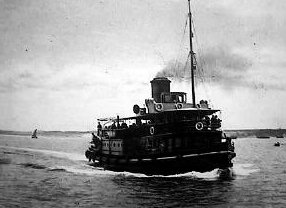
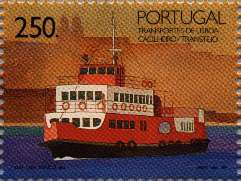

L to R: A Tagus river ferry c.1940; A Lisbon ferry on a 250 escudo stamp; the ferry "Cacilhense", July, 2000.
Porto Brandão Reg. No: L-3115-TL.
A car-ferry, built in 1955. 196 tons gross. 27m x 7.86m x 3m. 377 passengers and 4 crew.
Built by Blohm unde Voss, Hamburg as Falkenstein, to Lisbon 1977.
380hp diesel engine. Speed 10kt/hr. Inaugurated the Tagus river cruise
service on 5 June 1982. Overhauled 1984/5. Operates on the Belém -
Porto Brandão - Trafaria services.
Vouga Reg. No: L-3114-TL.
Sister to Mouraria, built in 1957 by Scheel und Johnk Schiffswerft.
as Otmarschen. 180 tons gross. 26.94m x 7.84m x 3m. 379 passengers
and 4 crew. Sold to Lisbon 1977. 420hp diesel engine, but refitted in 1994 with
a 317hp Cummins diesel engine. Speed 11kt/hr. Operates on the Belém -
Porto Brandão - Trafaria services.
Madragoa Reg. No: L-3141-TL.
Built in 1980/81 at Aveiro by Estaleiros S. Jacinto. A sister ship to the
Cacilhense, Campolide, Dafundo, Montes Claros,
Palmelense, Seixalense amd Sintrense. 313 tons gross. 31.35m
x 7.26m x 3.03m. 500 passengers and 4 crew. 770hp MTU diesel engine. Speed
10kt/hr. The vessel is seen, left, leaving Cacilhas in July 2003.
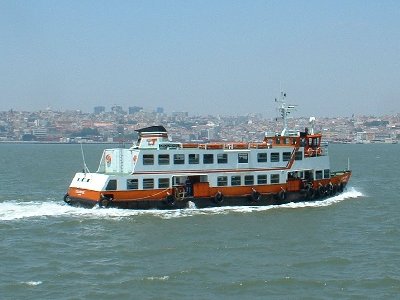 Cacilhense Reg. No: L-3140-TL.
Built in 1981 at Alverca do Ribatejo by Argibay. A sister ship to the
Madragoa, Campolide, Dafundo, Montes Claros,
Palmelense, Seixalense amd Sintrense. 305 tons gross.
31.35m x 7.26m x 3.03m. 500 passengers and 4 crew. 770hp MTU diesel engine. Speed
10kt/hr. Operates on the Cacilhas service.
Montes Claros Reg. No: L-3142-TL.
Built in 1981 at Aveiro by Estaleiros S. Jacinto and pictured above, right. A sister ship to the
Madragoa, Campolide, Dafundo, Cacilhense,
Palmelense, Seixalense amd Sintrense. 305 tons gross.
31.31m x 7.26m x 3.03m. 500 passengers and 4 crew. 770hp MTU diesel engine. Speed
10kt/hr. Operates on the Cacilhas service.
Seixalense Reg. No: L-3143-TL.
Built in 1982 at Alverca do Ribatejo by Argibay. A sister ship to the
Madragoa, Campolide, Dafundo, Cacilhense,
Palmelense, Montes Claros amd Sintrense. 305 tons gross.
31.37m x 7.26m x 3.03m. 500 passengers and 4 crew. 770hp MTU diesel engine. Speed
10kt/hr. Operates on the Cacilhas service.
Cacilhense Reg. No: L-3140-TL.
Built in 1981 at Alverca do Ribatejo by Argibay. A sister ship to the
Madragoa, Campolide, Dafundo, Montes Claros,
Palmelense, Seixalense amd Sintrense. 305 tons gross.
31.35m x 7.26m x 3.03m. 500 passengers and 4 crew. 770hp MTU diesel engine. Speed
10kt/hr. Operates on the Cacilhas service.
Montes Claros Reg. No: L-3142-TL.
Built in 1981 at Aveiro by Estaleiros S. Jacinto and pictured above, right. A sister ship to the
Madragoa, Campolide, Dafundo, Cacilhense,
Palmelense, Seixalense amd Sintrense. 305 tons gross.
31.31m x 7.26m x 3.03m. 500 passengers and 4 crew. 770hp MTU diesel engine. Speed
10kt/hr. Operates on the Cacilhas service.
Seixalense Reg. No: L-3143-TL.
Built in 1982 at Alverca do Ribatejo by Argibay. A sister ship to the
Madragoa, Campolide, Dafundo, Cacilhense,
Palmelense, Montes Claros amd Sintrense. 305 tons gross.
31.37m x 7.26m x 3.03m. 500 passengers and 4 crew. 770hp MTU diesel engine. Speed
10kt/hr. Operates on the Cacilhas service.
Monsanto Reg. No: L-3146-TL.
Built in 1982 at Aveiro by Estaleiros S. Jacinto. A sister ship to the
Madre de Deus, Miratejo and Moscavide. 280 tons gross.
31.36m x 7.26m x 3.03m. 507 passengers and 4 crew. 770hp MTU diesel engine. Speed
10kt/hr. Operated on the Montijo service; replaced by catamarans in September, 1995.
Moscavide Reg. No: L-3148-TL.
Built in 1982 at Aveiro by Estaleiros S. Jacinto. A sister ship to the
Madre de Deus, Miratejo and Monsanto. 280 tons gross.
31.36m x 7.26m x 3.03m. 507 passengers and 4 crew. 770hp MTU diesel engine. Speed
10kt/hr. Operated on the Montijo service; replaced by catamarans in
September, 1995.
Madre de Deus Reg. No: L-3149-TL.
Built in 1982 at Aveiro by Estaleiros S. Jacinto. A sister ship to the
Moscavide, Miratejo and Monsanto. 280 tons gross.
31.36m x 7.26m x 3.03m. 507 passengers and 4 crew. 770hp MTU diesel engine. Speed
10kt/hr.
Palmelense Reg. No: L-3145-TL.
Built in 1982 at Alverca do Ribatejo by Argibay. A sister ship to the
Madragoa, Campolide, Dafundo, Cacilhense,
Seixalense, Montes Claros amd Sintrense. 305 tons gross.
31.37m x 7.26m x 3.03m. 500 passengers and 4 crew. 770hp MTU diesel engine. Speed
10kt/hr. Still in service in 2012.
Sintrense Reg. No: L-3144-TL.
Built in 1982 at Alverca do Ribatejo by Argibay. A sister ship to the
Madragoa, Campolide, Dafundo, Cacilhense,
Palmelense, Montes Claros amd Seixalense. 305 tons gross.
31.37m x 7.26m x 3.03m. 500 passengers and 4 crew. 770hp MTU diesel engine. Speed
10kt/hr. Still in service in 2012.
Miratejo Reg. No: L-3151-TL.
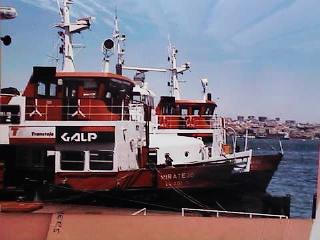 Built in 1982 at Aveiro by Estaleiros S. Jacinto. A sister ship to the
Madre de Deus, Moscavide and Monsanto. 280 tons gross.
31.36m x 7.26m x 3.03m. 507 passengers and 4 crew. 770hp MTU diesel engine. Speed
10kt/hr. Miratejo is pictured, right, with Moscavide at Cacilhas.
Campolide Reg. No: L-3152-TL.
Built in 1983 at Figueira da Foz by Foznave. A sister ship to the
Madragoa, Palmelense, Dafundo, Cacilhense,
Seixalense, Montes Claros amd Sintrense. 305 tons gross.
31.37m x 7.26m x 3.03m. 500 passengers and 4 crew. 770hp MTU diesel engine. Speed
10kt/hr.
Dafundo Reg. No: L-3150-TL.
Built in 1984 at Figueira da Foz by Foznave. A sister ship to the
Madragoa, Palmelense, Campolide, Cacilhense,
Seixalense, Montes Claros amd Sintrense. 305 tons gross.
31.37m x 7.26m x 3.03m. 500 passengers and 4 crew. 770hp MTU diesel engine. Speed
10kt/hr.
Almada Reg. No: L-3154-TL.
Built in 1969 at Hamburg by Scheel und Johnk as the Carl Kircheiss as an
Elbe river ferry. 147 tons gross. 30.34m x 6.3m x 2.1m. Two Mercedes Benz 300hp
engines. 167 passengers and 4 crew. Speed 12.7kt/hr. Bought in 1988 for the
Seixal service but mainly used for cruises.
Bairro Alto Reg. No: L-3166-TL.
Built in 1959 by Falkenbergs Varv AB of Falkenberg, Sweden, as the
Dan Viking. Sold to Lisbon in 1991 and entered service after a refit
in October 1993. 483 tons gross. 45.55m x 9.02m x 3m. Four Volvo Penta
204hp engines. 480 passengers and 5 crew. Speed 12kt/hr.
S. Jorge Reg. No: L-3163-TL.
Built in 1991/92 by Deggendorfer Werft und Eisenbau of Deggendorf,
Germany and after trials on the Danube, arrived in Lisbon in 1992 and
entered service, on charter to SOFLUSA on the T. Paço to Barreiro
service. 654 tons gross. 49.8m x 9.44m x 1.85m. Two MTU 598bhp
engines. 1000 passengers and 5 crew. Speed 13kt/hr. Sister ship to the Martim
Moniz.
Built in 1982 at Aveiro by Estaleiros S. Jacinto. A sister ship to the
Madre de Deus, Moscavide and Monsanto. 280 tons gross.
31.36m x 7.26m x 3.03m. 507 passengers and 4 crew. 770hp MTU diesel engine. Speed
10kt/hr. Miratejo is pictured, right, with Moscavide at Cacilhas.
Campolide Reg. No: L-3152-TL.
Built in 1983 at Figueira da Foz by Foznave. A sister ship to the
Madragoa, Palmelense, Dafundo, Cacilhense,
Seixalense, Montes Claros amd Sintrense. 305 tons gross.
31.37m x 7.26m x 3.03m. 500 passengers and 4 crew. 770hp MTU diesel engine. Speed
10kt/hr.
Dafundo Reg. No: L-3150-TL.
Built in 1984 at Figueira da Foz by Foznave. A sister ship to the
Madragoa, Palmelense, Campolide, Cacilhense,
Seixalense, Montes Claros amd Sintrense. 305 tons gross.
31.37m x 7.26m x 3.03m. 500 passengers and 4 crew. 770hp MTU diesel engine. Speed
10kt/hr.
Almada Reg. No: L-3154-TL.
Built in 1969 at Hamburg by Scheel und Johnk as the Carl Kircheiss as an
Elbe river ferry. 147 tons gross. 30.34m x 6.3m x 2.1m. Two Mercedes Benz 300hp
engines. 167 passengers and 4 crew. Speed 12.7kt/hr. Bought in 1988 for the
Seixal service but mainly used for cruises.
Bairro Alto Reg. No: L-3166-TL.
Built in 1959 by Falkenbergs Varv AB of Falkenberg, Sweden, as the
Dan Viking. Sold to Lisbon in 1991 and entered service after a refit
in October 1993. 483 tons gross. 45.55m x 9.02m x 3m. Four Volvo Penta
204hp engines. 480 passengers and 5 crew. Speed 12kt/hr.
S. Jorge Reg. No: L-3163-TL.
Built in 1991/92 by Deggendorfer Werft und Eisenbau of Deggendorf,
Germany and after trials on the Danube, arrived in Lisbon in 1992 and
entered service, on charter to SOFLUSA on the T. Paço to Barreiro
service. 654 tons gross. 49.8m x 9.44m x 1.85m. Two MTU 598bhp
engines. 1000 passengers and 5 crew. Speed 13kt/hr. Sister ship to the Martim
Moniz.
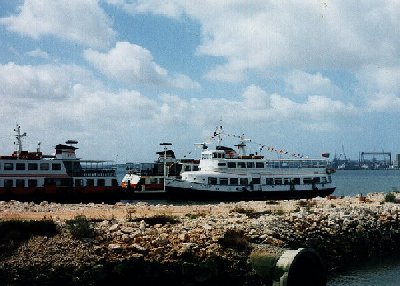
Martim Moniz Reg. No: L-3162-TL.
Built in 1991/92 by Deggendorfer Werft und Eisenbau of Deggendorf,
Germany and after trials on the Danube, arrived in Lisbon in 1992 and
entered service in December 1992, on charter to SOFLUSA, on the T. Paço to Barreiro
service. 654 tons gross. 49.8m x 9.44m x 1.85m. Two MTU 598bhp
engines. 1000 passengers and 5 crew. Speed 13kt/hr. Sister ship to the
S. Jorge.
S. Paulus
Since 1999 this ferry, painted in white and pictured left, has been evident in the TT fleet.
It was acquired from HADAG (Hamburg) where it operated as the St. Pauli. The vessel was built in 1959 as the Sülldorf and renamed in 1978.
Trafaria Praia Reg. No: L-3175-TL
A recent registration of a far from new vessel, not to be confused with a vessel of the same name which was retired and converted into an Algarve cruise ship (see below). This ferry, built in 1960, hails from the HADAG fleet in Hamburg where it operated as the Pöseldorf.
Part Two of this Page covers the Transtejo Catamaran and the former SOFLUSA ferry services, as well as the history of Trans-Tagus ferries. It also contains links to other Lisbon Ferry sites.
Copyright: ©
Contact: the following is not a link; please transcribe the address into your email 

 15 October 2016
15 October 2016
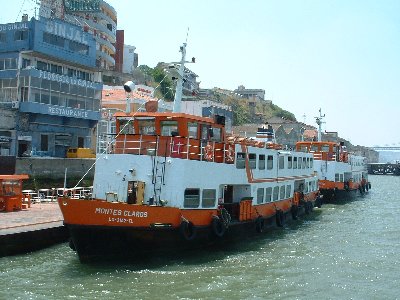



 The South and South East Station (Estação do Sul e Sueste) was an iconic ferry terminal - seen right - which lies just off the waterfront Praça do Comércio, to the east. It was actually a railway facility as well as a ferry terminal, for until late 1999 all CP railway services south of Lisbon had to be reached by taking the ferry from here to Barreiro.
The South and South East Station (Estação do Sul e Sueste) was an iconic ferry terminal - seen right - which lies just off the waterfront Praça do Comércio, to the east. It was actually a railway facility as well as a ferry terminal, for until late 1999 all CP railway services south of Lisbon had to be reached by taking the ferry from here to Barreiro.

 The presence of the Ponte 25 de Abril over the last five decades and the more recent opening of the rail section of that bridge have not, however, led to the complete demise of the short-distance cross-Tagus ferries. There remains an intensive passenger ferry service operated by
The presence of the Ponte 25 de Abril over the last five decades and the more recent opening of the rail section of that bridge have not, however, led to the complete demise of the short-distance cross-Tagus ferries. There remains an intensive passenger ferry service operated by 













